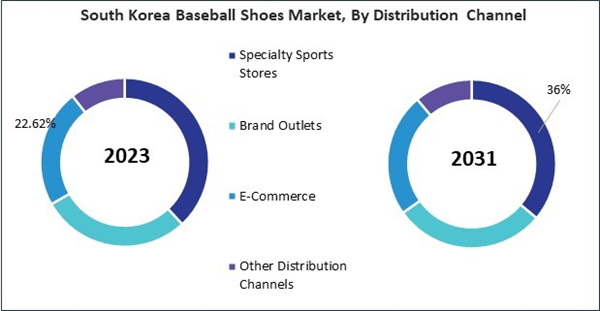Specialty sports stores focus on providing a curated selection of sports footwear, including cleats for various activities. These stores offer expert guidance and in-depth knowledge about different cleat types, making them a go-to destination for athletes seeking high-performance gear. The personalized service and specialized inventory cater to both competitive and recreational sports enthusiasts, helping them find the right equipment for their needs. Thus, the China market is expected to sale 406.33 thousand units of baseball shoes by specialty sport store by 2031.
The Japan market dominated the Asia Pacific Baseball Shoes Market by Country in 2023, and would continue to be a dominant market till 2031; thereby, achieving a market value of $728.6 million by 2031. The South Korea market is registering a CAGR of 8.2% during (2024 - 2031). Additionally, The Taiwan market would showcase a CAGR of 9.7% during (2024 - 2031).
During practice sessions, players focus on developing their skills and techniques, often spending long hours on their feet. Baseball shoes designed for training emphasize comfort and support, featuring cushioned insoles, arch support, and breathable materials to reduce fatigue and enhance overall comfort.
Additionally, training shoes may include features that help players refine their skills. For instance, shoes with adjustable cleats or removable spikes allow players to simulate different field conditions and effectively practice specific movements or drills.
Many Asia-Pacific countries are investing in youth baseball programs to foster early interest in the sport. Initiatives aimed at developing young talent create a growing market for baseball shoes as children and adolescents require appropriate footwear for training and competition. The inclusion of baseball in school and college sports programs across the region, particularly in Japan and South Korea, drives demand for baseball shoes. Educational institutions often invest in quality sports equipment, including footwear, for their student-athletes.
Based on Age Group, the market is segmented into Adults and Kids. Based on Type, the market is segmented into Metal Cleats, Molded Cleats, Turf Cleats, and Interchangeable Cleats. Based on Distribution Channel, the market is segmented into Specialty Sports Stores, Brand Outlets, E-Commerce, and Other Distribution Channels. Based on countries, the market is segmented into Japan, South Korea, Taiwan, Australia, China, New Zealand and Rest of Asia Pacific.
List of Key Companies Profiled
- Nike, Inc.
- Adidas AG
- PUMA SE (Groupe Artémis S.A.)
- SKECHERS USA, Inc.
- New Balance Athletics, Inc.
- Reebok International Ltd. (Authentic Brands Group LLC)
- ASICS Corporation
- Under Armour, Inc.
- Mizuno Corporation
- 3N2 LLC
Market Report Segmentation
By Age Group (Volume, Thousand Units, USD Billion, 2020-2031)
- Adults
- Kids
By Type (Volume, Thousand Units, USD Billion, 2020-2031)
- Metal Cleats
- Molded Cleats
- Turf Cleats
- Interchangeable Cleats
By Distribution Channel (Volume, Thousand Units, USD Billion, 2020-2031)
- Specialty Sports Stores
- Brand Outlets
- E-Commerce
- Other Distribution Channels
By Country (Volume, Thousand Units, USD Billion, 2020-2031)
- Japan
- South Korea
- Taiwan
- Australia
- China
- New Zealand
- Rest of Asia Pacific
Table of Contents
Companies Mentioned
- Nike, Inc.
- Adidas AG
- PUMA SE (Groupe Artémis S.A.)
- SKECHERS USA, Inc.
- New Balance Athletics, Inc.
- Reebok International Ltd. (Authentic Brands Group LLC)
- ASICS Corporation
- Under Armour, Inc.
- Mizuno Corporation
- 3N2 LLC









